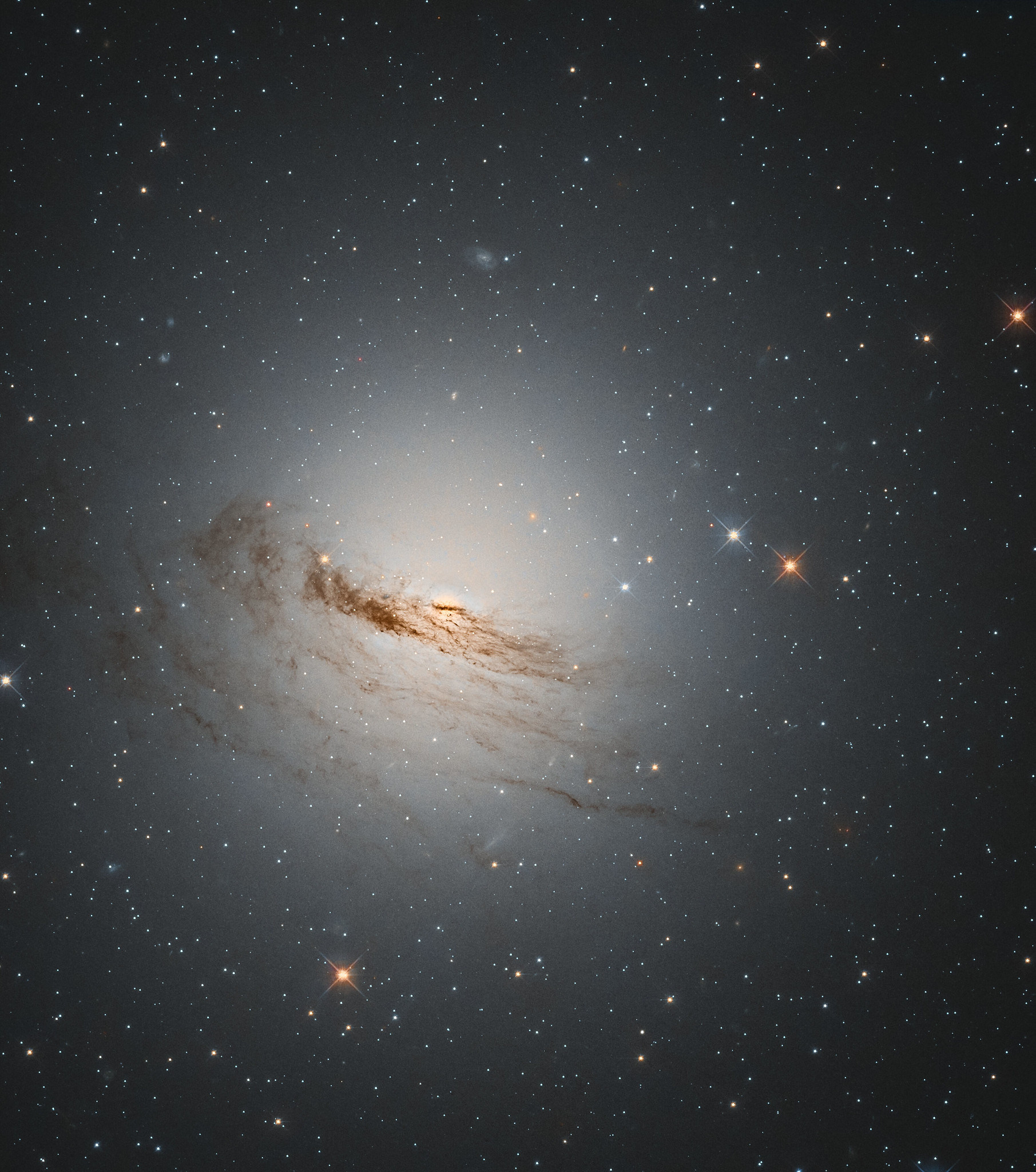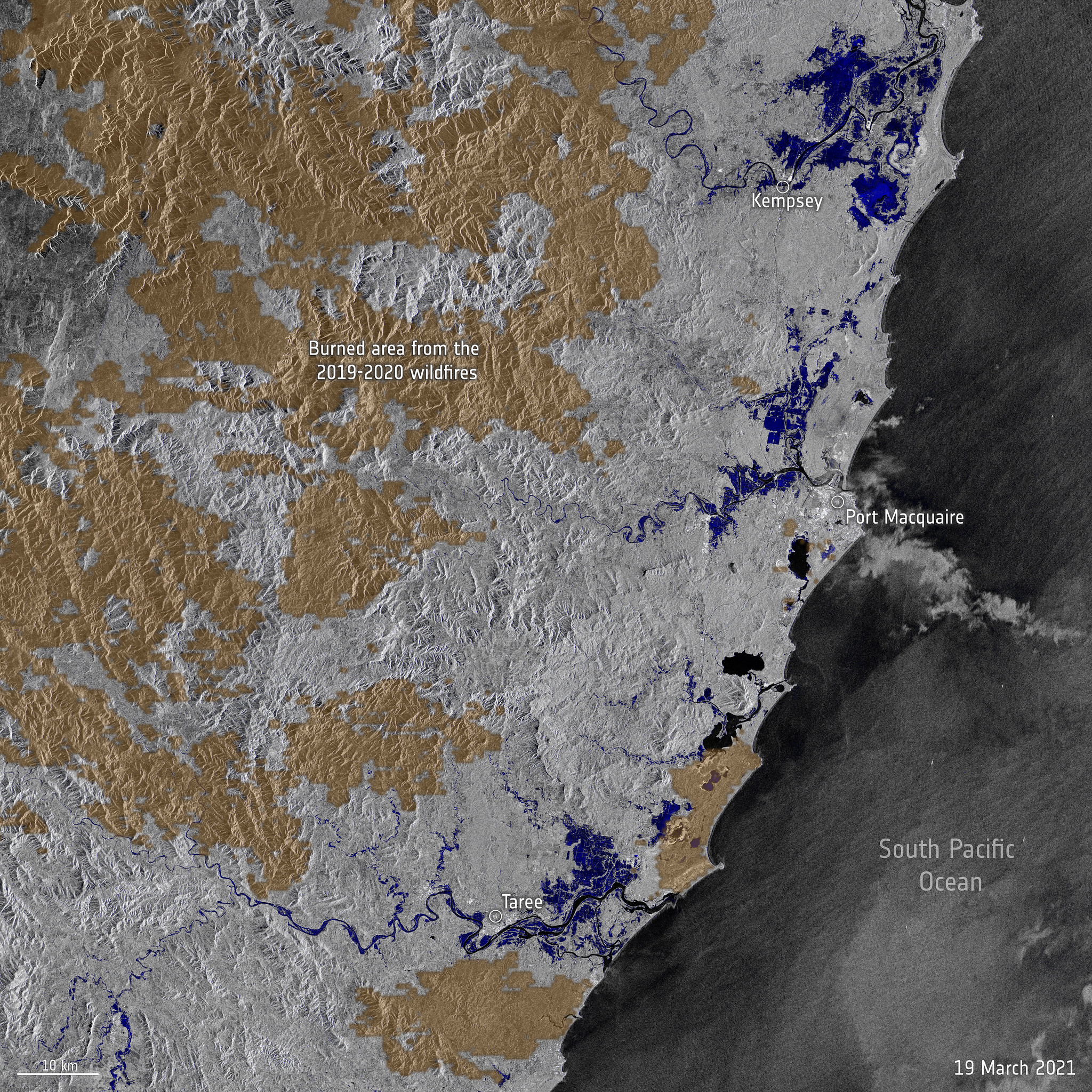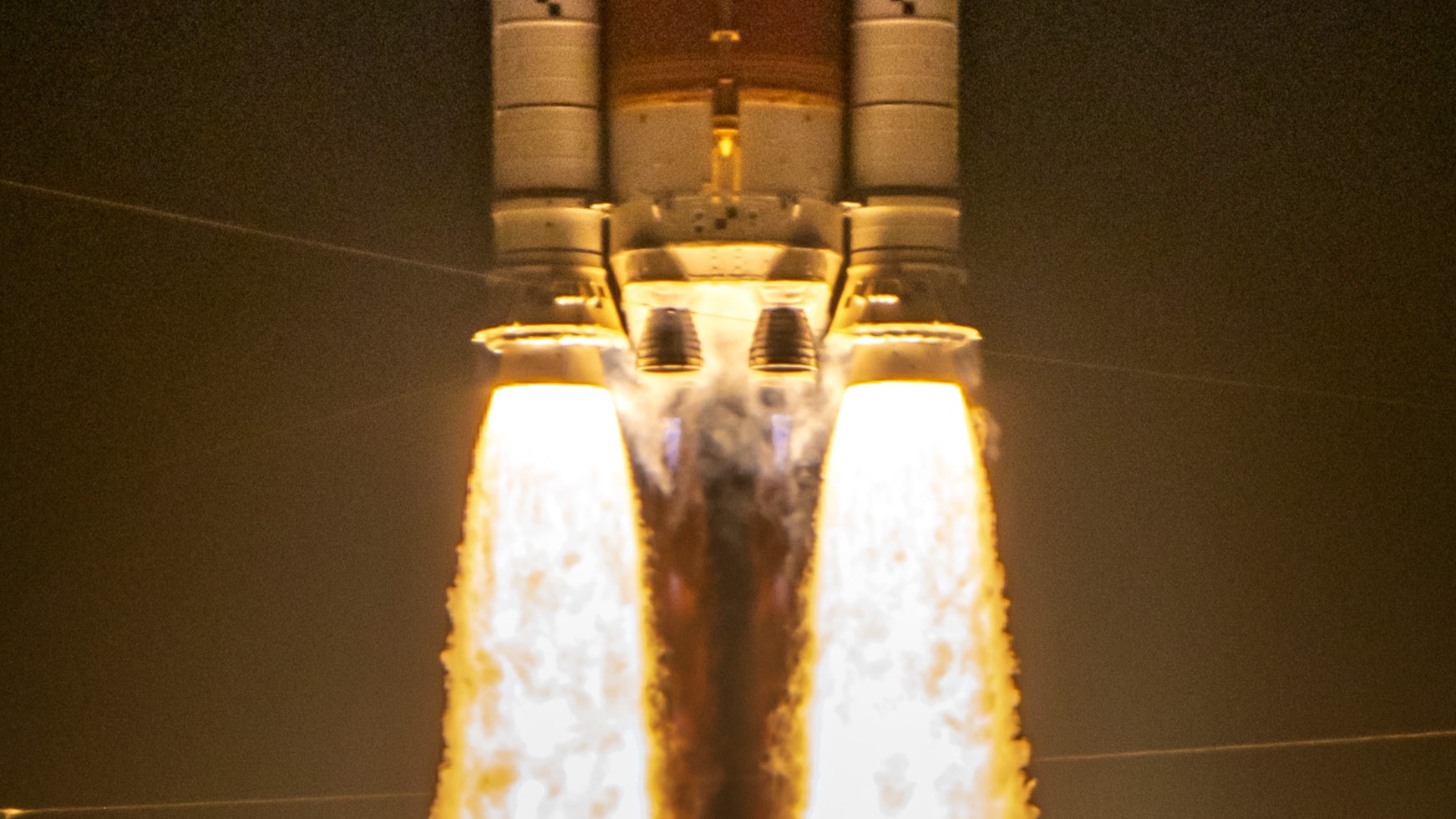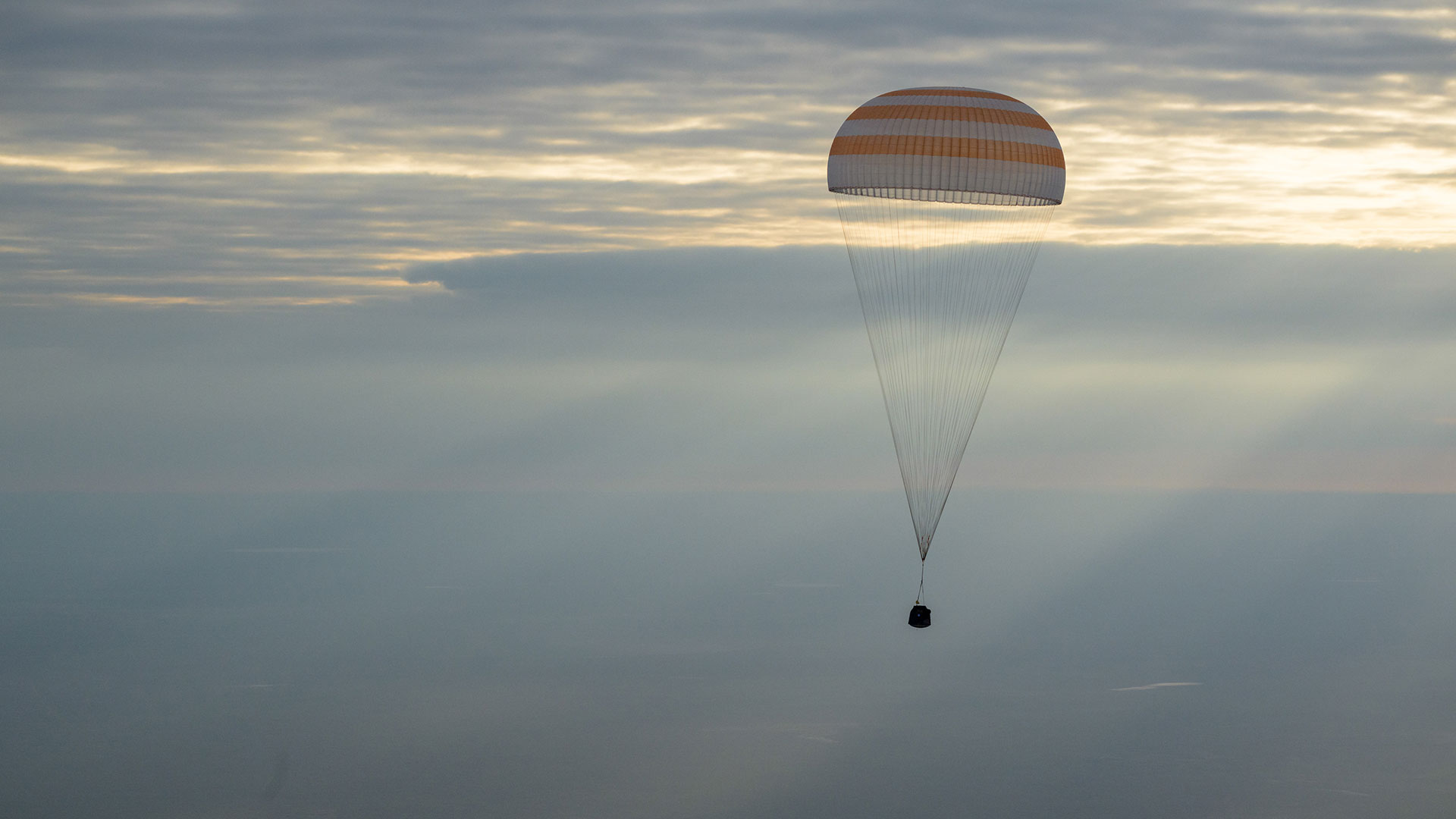March 2020
A comet and Jupiter

March 1, 2021: This image, captured by the Hubble Space Telescope, shows the comet P/2019 LD2 as it swoops closely to the Trojans, the ancient asteroids trapped near Jupiter by the planet's gravitational pull. This is the first comet that astronomers have observed near these ancient asteroids and the image reveals the comet's dust and gas tail trailing away from its glowing center (or nucleus). The comet was discovered in June 2019 and is likely among the comets journeying towards the Sun after escaping the Kuiper belt. -- Chelsea Gohd
A "black eye" galaxy

March 2, 2021: The Hubble Space Telescope snapped this image of the spiral galaxy NGC 4826, which can be found 17 million light-years away from Earth. The galaxy, which lies in the constellation of Coma Berenices (Berenice's Hair), is often called the "black eye" galaxy because of the dark band of dust and gas sweeping across it, which you can see in this image. -- Chelsea Gohd
Honoring with a name
![Recently, NASA named its headquarters building in honor of Mary W. Jackson, the agency's first African American female engineer. Here, Artist Tenbeete Solomon (AKA Trap Bob) (on the right) presents her artwork honoring Jackson to Wanda Jackson, Mary W. Jackson's granddaughter during the naming ceremony. Jackson, a mathematician and aerospace engineer, lead programs promoting the hiring and promotion of women in STEM [science, technology, engineering and mathematics] fields at NASA.](https://cdn.mos.cms.futurecdn.net/BqdC8Y2JVrDpNuUVvxyd9Y.jpg)
March 3, 2021: Recently, NASA named its headquarters building in honor of Mary W. Jackson, the agency's first African American female engineer. Here, Artist Tenbeete Solomon (AKA Trap Bob) (on the right) presents her artwork honoring Jackson to Wanda Jackson, Mary W. Jackson's granddaughter during the naming ceremony. Jackson, a mathematician and aerospace engineer, lead programs promoting the hiring and promotion of women in STEM [science, technology, engineering and mathematics] fields at NASA. -- Chelsea Gohd
Capturing Mars from space

March 4, 2021: This image from space, captured by the ESA-Roscosmos Trace Gas Orbiter, shows NASA's Perseverance rover, its back shell, heat shield and descent stage in Jezero Crater on the surface of the Red Planet. Perseverance landed in this ancient lake bed (a site that includes an ancient river delta) successfully on Feb. 18. The Trace Gas Orbiter watching from space captured this moment using its CaSSIS camera a few days after landing on Feb. 23. -- Chelsea Gohd
Planet-hunting with Plato

March 5, 2021: The European Space Agency's exoplanet-hunting spacecraft Plato has crossed another hurdle, with critical technology for its mission passing tests at the ESTEC Test Center in the Netherlands. The spacecraft will one day study and observe the cosmos from over 900,000 miles (1.5 million kilometers) away from Earth. -- Chelsea Gohd
ExoMars undergoes testing

March 8, 2021: The European Space Agency's ExoMars 2022 mission undergoes testing at Thales Alenia Space's facilities in France. The spacecraft is half of ESA's ExoMars mission, which began in 2001 and in 2016 launched an orbiter, the Trace Gas Orbiter, to Mars. The second half of this mission is this spacecraft, which contains the Rosalind Franklin rover in addition to the Kazachok surface platform, a carrier module and a descent module all destined for Mars. -- Chelsea Gohd
A big, beautiful galaxy

March 9, 2021: This big, beautiful and blue galaxy is formally known as NGC 2336. In this image, captured by the Hubble Space Telescope, you can see the barred spiral galaxy, which lies about 100 million light-years away in the constellation Camelopardalis (the Giraffe), stretching across the cosmos, with a "wingspan" measuring about 200,000 light-years. -- Chelsea Gohd
Get the Space.com Newsletter
Breaking space news, the latest updates on rocket launches, skywatching events and more!
Hydrogen in the Triangulum Galaxy

March 10, 2021: Stretching 1,500 light-years across, the ionized hydrogen in the Triangulum Galaxy shines bright in this image from the Hubble Space Telescope. The galaxy, more formally known as NGC 604, is a major area of star formation as this gas (most of which is hydrogen), collapses over time due to gravity, creating new stars. -- Chelsea Gohd
A bird's eye view

March 12, 2021: This striking image captured by JAXA astronaut Soichi Noguchi shows Olympic National Park in Washington State along with Vancouver in Canada. The astronaut snapped the photograph from the International Space Station and shared the colorful view on Twitter. The photo shows the blue of the water separating the blocks of land, most of which is speckled and coated with a thick billowy layer of clouds. -- Chelsea Gohd
Martian dunes

March 15, 2021: This picturesque scene, captured by the European Space Agency's ExoMars Trace Gas Orbiter, is a red, Martian dune field striped by wispy clouds. The landscape is located in the Lomonosov crater in Mars' northern hemisphere. The orbiter, which launched in 2016 and began full science operations in 2018, uses four instruments to take detailed images of Mars and study atmospheric processes. The data collected by the orbiter has aided in the scientific investigation of methane on Mars. -- Chelsea Gohd
Faint threads

March 16, 2021: Hubble spotted this lenticular galaxy, a cross between a spiral and elliptical-shaped galaxy, known as NGC 1947. The galaxy, which was originally discovered over 200 years ago, can only be viewed from the southern hemisphere and can be found in the Dorado (Dolphinfish) constellation about 40 million light-years away from Earth. -- Chelsea Gohd
The Emerald Isle

March 17, 2021: The Emerald Isle, otherwise known as Ireland, is seen here from space, imaged by NASA's Aqua satellite. The image, shared by NASA's History Office on Twitter for St. Patrick's Day, shows the nation's signature feature, visible all the way from space: the lush and rolling green hills that cover the Island which lies in the North Atlantic just to the west of Great Britain. -- Chelsea Gohd
Outflows from infant stars

March 18, 2021: Researchers using previously collected data from the Hubble and Spitzer space telescopes and the ESA's Herschel Space Telescope to study 304 developing stars in the Orion Complex, which is the closest star-forming region to Earth. In this new study, they looked at the star-forming process as, when hydrogen clouds collapse into new stars, there is a ton of leftover gas. Previously, scientists thought that the hot gas leaves young stars in outflowing jets and intense winds which stops its growth, but this new study finds fault in this explanation. -- Chelsea Gohd
A hot, hot fire

March 19, 2021: This billowing plume is coming from the core stage for NASA's Space Launch System rocket during a second hot fire test yesterday (March 18). The test, which took place on the B-2 Test Stand at NASA's Stennis Space Center near Bay St. Louis, Mississippi, lasted for almost 500 seconds (or over 8 minutes), far surpassing the 4-minute goal that the team set for the test. Hot fire tests ignite a rocket's engine, making sure it works as intended, without the rocket actually taking off anywhere. -- Chelsea Gohd
A re-energized planetary nebula

March 22, 2021: An unusual planetary nebula known as Abell 78 can be seen here in this image by the Hubble Space Telescope. The nebula lies about 5,000 light-years away in the Cygnus (the Swan) constellation and is a type of nebula often referred to as a "born again star." While nebulas often form from the gas and dust thrown off of dying stars as they exhaust their fuel and collapse, the star that formed this nebula stopped burning fuel and a thermonuclear reaction at its surface flung material away. -- Chelsea Gohd
Expedition 65

March 23, 2021: The astronauts making up the Expedition 65 crew all wave together at the Gagarin Cosmonaut Training Center (GCTC) in Star City, Russia. From the left, we see NASA astronaut Mark Vande Hei and Russian cosmonauts Oleg Novitskiy and Pyotr Dubrov. The trio is set to launch to the International Space Station April 9, 2021 from Baikonur Cosmodrome in Kazakhstan. -- Chelsea Gohd
A polarizing black hole

March 24, 2021: Astronomers have revealed a new view of the black hole at the heart of M87. In 2019, astronomers with the Event Horizon Telescope (EHT) collaboration released the first-ever image of a black hole. Now, they're showing the object in M87 in polarized light, shedding light on how magnetic fields behave close to black holes. -- Chelsea Gohd
Satellites map floods

March 25, 2021: Satellites captured this image across New South Wales, Australia, where devastating, record-breaking floods have forced thousands to evacuate their homes. The image was captured by the Copernicus Sentinel-1 mission, which is helping to map flooded areas to support relief and rescue efforts. The image was created from two separate images captured by Sentinel-1 on March 7 and 19, and you can see the flooded areas in dark blue. -- Chelsea Gohd
A bright spiral galaxy

March 26, 2021: In this image, captured by the Hubble Space Telescope, you can see the brilliant spiral galaxy NGC 7678. The galaxy, which was discovered in 1784 by astronomer William Herschel, is located about 164 million light-years from Earth in the constellation Pegasus. Stretching about 115,000 light-years across, the galaxy is about the same size as the Milky Way galaxy. -- Chelsea Gohd
Inspiration4 is ready

March 30, 2021: Today, the full crew for the upcoming Inspiration4 mission was announced. The crew, led by commander and billionaire tech entrepreneur Jared Isaacman, will include physician assistant and childhood bone cancer survivor Hayley Arceneaus as well as Lockheed Martin employee and U.S. Air Force veteran Christopher Sembroski and Sian Proctor, a geologist, analog astronaut and artist who is a professor of planetary science at the South Mountain Community College in Arizona, both of whom were announced today. The mission will see the crew spend about three days orbiting the Earth in a SpaceX Crew Dragon vehicle, which Isaacman has chartered. -- Chelsea Gohd
Magical hour with the moon

March 31, 2021: Astronaut Soichi Noguchi shared this view of the squashed moon that he captured from the International Space Station in a Twitter post today.
"Magical hour - 17th moon rise over Earth atmosphere," Noguchi, an astronaut with the Japan Aerospace Exploration Agency, wrote.
The squashed view of the moon is an optical illusion created as the moon was rising over edge, or limb, of the Earth as viewed from the space station. From Noguchi's perspective, the moon looked squashed, but the distortion was by the interference of the Earth's atmosphere between the astronaut and the moon. -- Tariq Malik
Can't find the date you're looking for? It may have been a weekend or holiday, when we don't normally update our Image of the Day.
Click 'NEXT PAGE' below for April >
Check out our Image of the Day Archives for more awesome photos.
Image of the Day 2023 Archive

Image of the Day 2022 Archive

Image of the Day 2021 Archive

Image of the Day 2020 Archive

Image of the Day 2019 Archive

Join our Space Forums to keep talking space on the latest missions, night sky and more! And if you have a news tip, correction or comment, let us know at: community@space.com.

Space.com is the premier source of space exploration, innovation and astronomy news, chronicling (and celebrating) humanity's ongoing expansion across the final frontier. Originally founded in 1999, Space.com is, and always has been, the passion of writers and editors who are space fans and also trained journalists. Our current news team consists of Editor-in-Chief Tariq Malik; Editor Hanneke Weitering, Senior Space Writer Mike Wall; Senior Writer Meghan Bartels; Senior Writer Chelsea Gohd, Senior Writer Tereza Pultarova and Staff Writer Alexander Cox, focusing on e-commerce. Senior Producer Steve Spaleta oversees our space videos, with Diana Whitcroft as our Social Media Editor.









